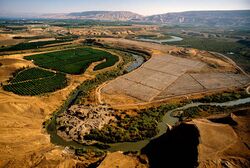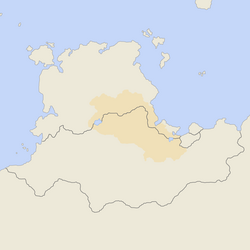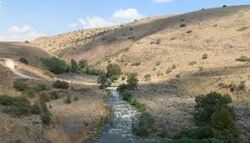Yarden River Valley: Difference between revisions
m (→North Bank) |
mNo edit summary |
||
| (One intermediate revision by one other user not shown) | |||
| Line 1: | Line 1: | ||
{{Region_icon_Ajax}} | |||
{{WIP}} | {{WIP}} | ||
[[File:Yarden River Valley pic 1.jpeg|thumb|right|250px|A crest of the [[Yarden River]], the northernmost part of the [[Sydalon-Yisrael border]].]] | |||
The '''Yarden River Valley''' ({{wp|Modern Hebrew language|Hebrew}}: עֵמֶק הַיַרְדֵּן, ''Emek HaYarden'' | The '''Yarden River Valley''' ({{wp|Modern Hebrew language|Hebrew}}: עֵמֶק הַיַרְדֵּן, ''Emek HaYarden''; [[Standard Latin language|Latin]]: ''Cultivida''), alternately referred to as the '''Yarden Valley''', is the {{wp|drainage basin}} of the [[Yarden River]] in [[Ajax#Continents|Northwest Scipia]]. The Valley begins around the {{wp|watershed}} of the {{wp|Kinnereth Sea|Kinneres Sea}} (the {{wp|headwaters}} of the Yarden River) and follows the course of the river until its end in the {{wp|Dead Sea|Great Salt Sea}}. The Yarden Valley, as defined by the reach of the flooding of river-water and branching off {{wp|tributaries}}, encompasses an area approximately 72,416 km sq. The Yarden River, the source and central feature of the Valley, marks [[Sydalon-Yisrael border|the border between Sydalon and Yisrael]]. Due to religious, national, historical, {{wp|geostrategy|geostrategic}}, and agricultural significance and concerns, the Yarden River Valley has been the major factor between the [[West Scipian Wars]] and the [[West Scipian Contention]] between [[Yisrael]] and [[Sydalon]]. The [[Yarden Accords|1973 Yarden Accords]] formally divided the Yarden Valley between the two powers along the course of the Yarden River under {{wp|international customary law}}. | ||
==Introduction== | ==Introduction== | ||
==Geography== | ==Geography== | ||
[[File:Yarden Valley location.png|thumb|right|250px|Map of the Yarden Valley with national borders.]] | |||
===Physical geography=== | ===Physical geography=== | ||
===Political geography=== | ===Political geography=== | ||
| Line 27: | Line 29: | ||
==History== | ==History== | ||
==Agriculture== | ==Agriculture== | ||
[[File:Yarden River Valley pic 2.jpeg|thumb|left|250px|The Yarden River by the [[Nobility_of_Sydalon#Counts_and_Counties|County of Melfi]] in [[Sydalon]], a {{wp|semi-arid}} region known for its {{wp|olive tree|olive groves}}.]] | |||
The Yarden River Valley is approximately 10 degrees warmer than adjacent mountainous areas (the Judean and TBD Mountains), as well as about 3-6 degrees warmer than nearby {{wp|seacoast|coastal land}} due to [[Ajax|global]] {{wp|air current}}s. Its all-season agricultural climate, extremely fertile soils, and ready water supply made it a major region for agriculturical production dating back at least 5,000 years ago. By about 3,000 BCE, produce and crops from the Valley were being exported to other areas of Scipia and potentially across the [[Ajax|Periclean Sea]] to [[Ajax#Continents|southern Belisaria]]. | The Yarden River Valley is approximately 10 degrees warmer than adjacent mountainous areas (the Judean and TBD Mountains), as well as about 3-6 degrees warmer than nearby {{wp|seacoast|coastal land}} due to [[Ajax|global]] {{wp|air current}}s. Its all-season agricultural climate, extremely fertile soils, and ready water supply made it a major region for agriculturical production dating back at least 5,000 years ago. By about 3,000 BCE, produce and crops from the Valley were being exported to other areas of Scipia and potentially across the [[Ajax|Periclean Sea]] to [[Ajax#Continents|southern Belisaria]]. | ||
| Line 35: | Line 37: | ||
==Religious significance== | ==Religious significance== | ||
[[File:Yarden River Valley pic 4.jpg|thumb|right|250px|{{wp|Yardenit|Yardenis}}, a significant Christian pilgrim site.]] | |||
The river valley and its surrounding lands hold special religious and spiritual importance to both {{wp|Judaism}} and {{wp|Christianity}}. The Yarden River is held sacred in Christian belief as where the Messiah was baptized. For Jews, the Yarden Valley was site of numerous miracles, such as the {{wp|Battle of Jericho|Battle of Yericho}}, as told by the {{wp|Hebrew Bible}}, and a vessel for {{wp|God|Hashem}} to deliver life-sustaining water and sustenance to the Jewish people in [[Yisrael|their lands]]. | |||
===Pilgrimage and tourism=== | ===Pilgrimage and tourism=== | ||
Numerous cities, battles, events, and the graves of figures described or cited in the Bible, both for Jews and Christians, are scattered across the Yarden River Valley. | |||
Some examples include: | |||
* The cities of {{wp|Jericho|Yericho}}, {{wp|Bethlehem|Beis LeChem}}, {{wp|Nazareth|Nazres}}, and {{wp|Hebron|Chevron}}, all of whom feature prominently in the Bible; | |||
* The foothills of the [[Judean Mountains]], where the story of the {{wp|Chanukkah}} Revolt by the {{wp|Hasmoneans|Chasmoni}} primarily occurred; | |||
* Numerous Christian monasteries and convents on either side of the River Yarden; | |||
* Farms in the valley reportedly containing over 3,000 year-old olive and grape vines, some of whom that have been in near continuous use since {{wp|antiquity}}. | |||
==See also== | ==See also== | ||
* [[Sydalon-Yisrael border]] | * [[Sydalon-Yisrael border]] | ||
* [[Sydalon-Yisrael relations]] | * [[Sydalon-Yisrael relations]] | ||
* [[Outer Yisrael]] | * [[Outer Yisrael]] | ||
* [[ | * [[Hayan|Duchy of Hayan]] ([[Sydalon]]) | ||
* [[ | * [[Melfi|Duchy of Melfi]] ([[Sydalon]]) | ||
* [[Royal | * [[Tiberias|Duchy of Tiberias]] ([[Sydalon]]) | ||
* [[Royal Domain (Sydalon)|Sydalene Royal Domain]] ([[Political_divisions_of_Sydalon#Royal_Domain|Seressi]]) | |||
[[Category:Geography]] | [[Category:Geography]] | ||
[[Category:Sydalon]] | [[Category:Sydalon]] | ||
[[Category:Yisrael]] | [[Category:Yisrael]] | ||
Latest revision as of 18:46, 30 May 2021
This article is incomplete because it is pending further input from participants, or it is a work-in-progress by one author. Please comment on this article's talk page to share your input, comments and questions. Note: To contribute to this article, you may need to seek help from the author(s) of this page. |
The Yarden River Valley (Hebrew: עֵמֶק הַיַרְדֵּן, Emek HaYarden; Latin: Cultivida), alternately referred to as the Yarden Valley, is the drainage basin of the Yarden River in Northwest Scipia. The Valley begins around the watershed of the Kinneres Sea (the headwaters of the Yarden River) and follows the course of the river until its end in the Great Salt Sea. The Yarden Valley, as defined by the reach of the flooding of river-water and branching off tributaries, encompasses an area approximately 72,416 km sq. The Yarden River, the source and central feature of the Valley, marks the border between Sydalon and Yisrael. Due to religious, national, historical, geostrategic, and agricultural significance and concerns, the Yarden River Valley has been the major factor between the West Scipian Wars and the West Scipian Contention between Yisrael and Sydalon. The 1973 Yarden Accords formally divided the Yarden Valley between the two powers along the course of the Yarden River under international customary law.
Introduction
Geography
Physical geography
Political geography
The Yarden River Valley is approximately 72,416 kn sq. Of that, about 37.8% is in Sydalon and 62.2% is in Yisrael.
North Bank
The Sydalene portion of the Valley, sometimes known as the North Bank, is 27,360 km sq and consists of the whole of the Duchy of Hayan and County of Melfi as well as parts of the Royal Domain such as the County of Mirabel. Colloquially, the North Bank is often referred to as the Cultivida.
Several major cities lie in the Yarden Valley, including Zippori, Hamrun, and Hayan.
South Bank
The Yisraeli side of the Yarden Valley, also referred to as the South Bank, is 45,056 km sq. About 88% of the Valley is enclosed in the Yarden Valley Special District, with the remainder being in neighboring jurisdictions such as the Yerushalayim, Central, and Northern districts.
The major city of Chevron resides in the south-central Yarden Valley, while smaller cities and towns with religious significance such as Yericho and Beis LeChem are also located in this region.
Demography
Sydalon
Yisrael
History
Agriculture
The Yarden River Valley is approximately 10 degrees warmer than adjacent mountainous areas (the Judean and TBD Mountains), as well as about 3-6 degrees warmer than nearby coastal land due to global air currents. Its all-season agricultural climate, extremely fertile soils, and ready water supply made it a major region for agriculturical production dating back at least 5,000 years ago. By about 3,000 BCE, produce and crops from the Valley were being exported to other areas of Scipia and potentially across the Periclean Sea to southern Belisaria.
The area's high-yielding and productive farmlands were chronicled repeatedly in the Hebrew Bible. Modern and contemporary methods of farming have significantly amplified the agricultural output of the Valley since the 1850s.
The Yarden River Valley southern bank is known as the "breadbasket" of Yisrael.
Religious significance

The river valley and its surrounding lands hold special religious and spiritual importance to both Judaism and Christianity. The Yarden River is held sacred in Christian belief as where the Messiah was baptized. For Jews, the Yarden Valley was site of numerous miracles, such as the Battle of Yericho, as told by the Hebrew Bible, and a vessel for Hashem to deliver life-sustaining water and sustenance to the Jewish people in their lands.
Pilgrimage and tourism
Numerous cities, battles, events, and the graves of figures described or cited in the Bible, both for Jews and Christians, are scattered across the Yarden River Valley.
Some examples include:
- The cities of Yericho, Beis LeChem, Nazres, and Chevron, all of whom feature prominently in the Bible;
- The foothills of the Judean Mountains, where the story of the Chanukkah Revolt by the Chasmoni primarily occurred;
- Numerous Christian monasteries and convents on either side of the River Yarden;
- Farms in the valley reportedly containing over 3,000 year-old olive and grape vines, some of whom that have been in near continuous use since antiquity.


